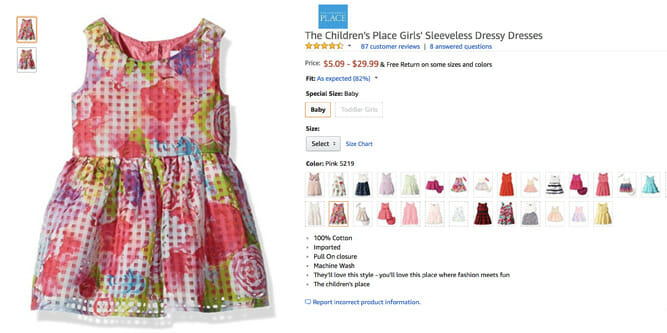
Photo: The Children’s Place
January 15, 2018
Co-opetition with Amazon works for The Children’s Place
While many retailers view Amazon.com as a competitive threat to be fought at every turn, others have found benefits in co-opetition — competing with the e-tail giant on one hand while taking advantage of the site’s traffic to sell on its marketplace. One case in point is The Children’s Place.
When Jane Elfers joined the children’s clothing retailer as president and chief executive officer in 2010, nine percent of the company’s sales were transacted online. By the end of this year, Ms. Elfers told CNBC’s Jim Cramer in a recent interview, she expects e-commerce to represent around 23 percent of the retailer’s total.
Ms. Elfers said that the move to sell on Amazon in 2014 enabled the chain to focus on growing sales across all its touchpoints instead of worrying about how to ward off the e-tailer.
“I think the combination of having 1,000 brick-and-mortar stores and a really robust e-commerce business is really part of the key to the success of The Children’s Place,” she told Mr. Cramer. “They [parents] bring the kids in, the kids get to pick what they want, and then that kind of feeds on itself and they go back and also buy on e-commerce.”
Success, regardless of where the sale transaction takes place, is about being focused on the needs of customers, said Ms. Elfers. In the case of The Children’s Place, that means Millennial moms, and it’s that very customer “who’s pushing us from a digital point of view even faster than we can push ourselves,” she said.

Being able to attract sellers to its marketplace has been a key driver of Amazon’s growth over the years. The site offers over 480 million products for sale. As a point of comparison, it has been estimated that Walmart sells somewhere between two and five percent of the SKUs offered by Amazon.
Jeff Bezos and company receive a big benefit from marketplace sellers. As Chris Petersen, PhD., president, Integrated Marketing Solutions, wrote on RetailWire in last October, Amazon only has “to stock less than 10 percent of the actual inventory” listed on the site and third-party sellers on the site help subsidize its “infrastructure and systems costs.”
Discussion Questions
DISCUSSION QUESTIONS: Do you generally come down on the side of competition or co-opetition when it comes to Amazon? Will more large retailers follow the path of The Children’s Place and sell their products on Amazon and perhaps other marketplaces such as Walmart’s in the next few years?
Poll
BrainTrust
Phil Chang
Podcast Host, Retail Influencer, Fractional CMO
Ryan Mathews
Founder, CEO, Black Monk Consulting
Recent Discussions







The Children’s Place obviously is very confident in the strength of its brand. It knows full well that Amazon will be monitoring the data on CP SKU views, purchases, and clickstreams around its items in order to drive decisions about its own private label goods. Also, I believe CP does not sell children’s goods featuring licensed characters from Disney, Marvel, etc. This is a big category for Amazon, so it is not concerned about competition here with CP.
Co-opetition … almost every time. The new age of retail isn’t about “us vs them” anymore. It’s about who can reach the most consumers as quickly as possible to keep converting them. I believe that in the new age of retail, it’s critical to maximize your commercial distribution points.
The critical piece here is ensuring that your building blocks or fundamentals are in order. Pricing and packaging in particular so you know who is a good commercial partner as soon as you meet them.
Phil hits the nail on the head. The branding plan must be strategic to growth, and then exploit the tactical consumer connection points. Brand-friendly engagement policies and approaches are the table stakes in brand growth.
Amazon is both a competitor and a firm with which retailers can cooperate. That said, other retailers need to be aware of the pitfalls of dealing with Amazon. Not least the fact that they don’t always have control over things like product placement and that they are strengthening a brand that may not align with their interests in the future.
As with all disruption, there’s no point in retailers just ignoring it, sticking their head in the sand and praying that it just goes away. Amazon and other big e-retailers exist and they are growing because they provide convenience and speed.
I know it’s not a popular viewpoint, but I really do think that brick and mortar retailers can learn a lot from the online giants and partnering with them makes sound business sense. In fact, retail has been slower than many other sectors to embrace the opportunities that disruptive competitors present.
Yes, Amazon is a big threat but it’s one that can be leveraged. Selling a small selection of products on Amazon – and many retailers in the U.K. choose to sell only sale products to shift oversupply — builds name recognition, especially for smaller brands, and brings a filtered selection of products to a new audience. This can encourage customers to visit the physical store to check out what else they offer. It’s not the right strategy for every retailer – high-end brands might struggle to see any reward – but for many it is a case of: you can’t beat them so you’d better join them.
Since, for most retailers, long term competition isn’t a viable option, that leaves the co-opetition. That said, Amazon has a way of eating its old friends, so retailers will have to be careful how they work with Amazon. As to whether other large retailers will follow the Children’s Palace model, I think it depends on the retailer, their brand strength and what kind of a deal they can get from Amazon. If enough large retailers jump on the Amazon bandwagon it will be harder and harder for the rest of them to resist.
Let the wolf into the hen house, or potentially lose out on revenue from customers who prefer to shop on Amazon?
As The Children’s Place has found, retailers with a strong value proposition can benefit greatly by using Amazon as an additional marketing and distribution channel. The Children’s Place have their own unique branded products, which makes their assortment on Amazon defensible. Retailers who only sell products manufactured by other brands have little to gain by competing with other sellers who are all selling the same products.
The other approach that brands and retailers can take is to sell a specific assortment on Amazon, and retain some unique portion of their assortment to carry in stores or on their ecommerce platform. This addresses concerns about cannibalization across channels.
The CEO of The Children’s Place has been forward-thinking on this front. Amazon produces much hand-wringing from other retailers who haven’t been willing to address the changing market head-on; but Jane Elfers has taken a firm viewpoint and it has paid off.
Ms. Elfers is being very practical about co-opetition with Amazon. In the children’s category, Toys “R” Us did the opposite and I’m certain they made the wrong decision by not focusing on the needs and desires of the Millennial shoppers. As long as The Children’s Place doesn’t lose focus on the brand, the quality of goods and the IRL shopping experience, this partnership should be viable. Until Amazon learns and invests in private brand kids’ clothes….
What’s the old expression? “If you can’t beat them, join them.” In this case The Children’s Place could be making a very strong and shrewd business move. They realize the value of e-commerce, no matter what the source. It is added revenue. It also can drive traffic to the stores. So “why not?” is not even a question. More so, the question should be “how soon?”
When it comes to Amazon, co-opetition is the name of the game. Brick and mortar retailers need to be exposed to where and how their customers shop. Their revenues and growth are limited by the location of their physical stores. With an e-commerce website, they extend their “trade area” but nowhere as much as they can by working with Amazon.
There’s always a risk regarding what Amazon can do strategically with all the granular data it collects and the insights gained by applying artificial intelligence across aggregate purchase and SKU histories.
Co-opetition is appropriate in today’s retail environment. It allows one to survive today and fight another day.
I’d just offer Ms. Elfers a caution: Amazon has not proven to be a reliable partner over the years. I know many Amazon sellers who are now having the screws put on them by Amazon. While Amazon is less of a pivot risk than other digital efforts, they still will radically change business as needed to please investors — even if that hurts long term loyal vendors.
It’s worth remembering that in any relationship with Amazon, they are the big dog. When you fit with their direction things can be stupendous. When you don’t, your business can collapse if you invested too much assuming Amazon loyalty.
Avoiding Amazon (or trying to compete with them) is futile at this point. It’s where the vast majority of shoppers start product searches and they have no problem competing on price.
While there’s risk involved in letting Amazon in on your sales data, avoiding the marketplace altogether isn’t a sound strategy. In the past year Nike has started selling on Amazon and Kohl’s has started taking Amazon returns and showcasing their smart home devices. Amazon is the current king of retail, so leveraging their platform and customer base in a calculated way is the best way forward.